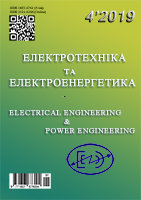MODIFICATION OF NUMERAL CALCULATION OF TRANSIENTS IN ELECTRIC CIRCUITS ON BASIS OF TCHEBYSHEV’S POLYNOMIALS
DOI:
https://doi.org/10.15588/1607-6761-2019-4-2Keywords:
transient, numeral methods, scheme model, polynomial approximationAbstract
Purpose. Modification of the numerical calculation method of transients in linear electric circuits, as well as the development of a schematic model of the method, leading to ease the calculation and to increase the speed of calculation on a computer..
Methodology. Polynomials approximation of functions, numeral methods of solution of integro-differential equations, matrix methods, computer programming and methods of electric circuits theory are used.
Findings The improved method of transient calculation is worked out as the modification of the known one. It allows to reduce the computer modeling time of dynamic electric processes in linear electric circuits. The example of the application of the proposed method is shown. Based on the developed method, the computer program was compiled for calculating the transient in the model circuit. This example showed the reduction in CPU time of 45% compared with the use of known methods
Originality. The approximation of the functions of currents with time by series in the Chebyshev orthogonal polynomials is used. Chebyshev polynomials possess the property of the approximation error uniformity of functions in the entire range of the argument, which distinguishes them from a number of other orthogonal functions. It is proposed to use a polynomial approximation not of the solution functions themselves, but of its derivative. This significantly reduces the approximation error of both the solution function and the derivative of the solution, which appears in the calculation method.. It is shown how, in the proposed method, integro-differential equations of state are transformed into linear algebraic equations. The schematic model of the proposed numerical calculation method is developed. The schematic model allows you to move from an electrical circuit in which processes are described by integro-differential equations to an equivalent circuit with images of currents. Images of true currents in the equivalent circuit are interpreted as direct currents. It is shown that the Kirchhoff laws are valid for current images in the equivalent circuit, which leads to the calculation of a system of algebraic equations. Such a circuit model creates convenience for an engineer performing transient calculations.
Practical value. The developed method opens up the possibility of using the entire diverse apparatus of the theory of electric circuits for working with current images. Based on this, a universal software package is developed for calculating transients in electrical circuits of arbitrary
References
[1] Electromagnetic transient program (EMTP) applicationguide (1986). // epri report no: el – 4650, project 2149–1, Westinghouse electric corp., Pittsburgh.
[2] Keoun, D., (2008). Orcad Pspice. analiz jelektricheskih cepej. Piter, 640.
[3] Chernyh, I.V. (2003). Simulink sreda sozdanija inzhenernyh prilozhenij, Moscow, dialog-mifi, 496.
[4] Tatevjan, S.K., (2002). Chislennoe integrirovanie obyknovennyh differencial'nyh uravnenij s ispol'zovaniem rjadov Chebyshjova. Vychislitel'nye metody i programmirovanie, 3, 52-81.
[5] Pashkovskij, S. (1983). Vychislitel'nye primenenija mnogochlenov i rjadov Chebysheva. Moscow, Nauka, 384.
[6] Tihovod, S.M., (2013). Ispol'zovanie polinomov Chebysheva dlja rascheta perehodnyh processov v jelektricheskih cepjah. Vіsnik nacіonal'nogo unіversіtetu «HPI», 1, 91-105.
[7] Tikhovod, S.M., (2015). Raschet perekhodny`kh proczessov v transformatorakh na osnove magnitoe`lektricheskikh skhem zameshheniya s ispol`zovaniem polinomov Cheby`shyova. Elektrotekhnika ta elektroenergetika, 2, 5-14.
[8] Tikhovod, S.M., (2016). Calculation of transient processes in electrical circuits using Chebyshev polynomials. Russian electrical engineering, 3, 172-180.
[9] Amosov, A. A., Dubinskij, N. V., (1994). Vy`chislitel`ny`e metody` dlya inzhe-nerov. Moscow, Vy`ssh. shk., 544.
[10] Tihovod, S.M. (2015). Raschet perehodnyh processov v magnitojelektricheskih cepjah pri ispol'zovanii polinomial'noj approksimacii reshenija. Izvestija vysshih uchebnyh zavedenij. jelektromehanika, 3, 25-32.
[11] Tihovod, S.M., Kornus, T.M., Patalah D., (2015). Metod uskorennogo chislennogo rascheta perehodnyh processov v jelektricheskih cepjah na osnove approksimacii reshenija algebraicheskimi polinomami. Elektrotehnіka ta elektroenergetika, 2, 11-24.
[12] Bahvalov, N.S. Zhidkov, N.P., Kobel'kov, G.M., (1987). Chislennye metody. Moscow, Nauka, 630.
[13] Vasil'ev, N.I., Klokov, Ju.A., Shkerstena A.Ja., (1984). Primenenie polinomov Chebysheva v chislennom analize. Riga, Zinatne, 240.
[14] Danilov, Ju.A., (1984). Mnogochleny Chebysheva. Minsk, Vyshjejshaja shkola, 157.
[15] II'ina, V.A. Silaev, P.K., (2003). Chislennye metody dlja fizikov-teoretikov.1. Moskva-Izhevsk: institut komp'juternyh issledovanij 132.
[16] Chua, L.O., Pen–Min Lin, (1980). Mashinny`j analiz e`lektronny`kh skhem: Algoritmy` i vy`chislitel`ny`e metody. Moscow, E`nergiya, 640.
Downloads
Published
How to Cite
Issue
Section
License
Copyright (c) 2020 D. Patalakh

This work is licensed under a Creative Commons Attribution 4.0 International License.
Creative Commons Licensing Notifications in the Copyright Notices
Authors who publish with this journal agree to the following terms:
Authors retain copyright and grant the journal right of first publication with the work simultaneously licensed under aCreative Commons Attribution License that allows others to share the work with an acknowledgement of the work's authorship and initial publication in this journal.
Authors are able to enter into separate, additional contractual arrangements for the non-exclusive distribution of the journal's published version of the work (e.g., post it to an institutional repository or publish it in a book), with an acknowledgement of its initial publication in this journal.
Authors are permitted and encouraged to post their work online (e.g., in institutional repositories or on their website) prior to and during the submission process, as it can lead to productive exchanges, as well as earlier and greater citation of published work.

